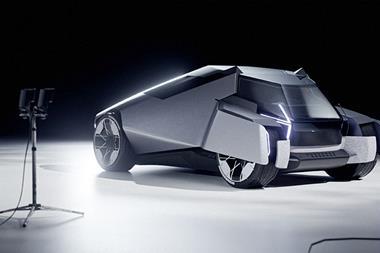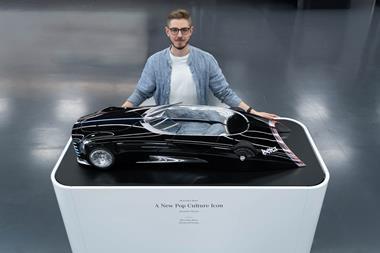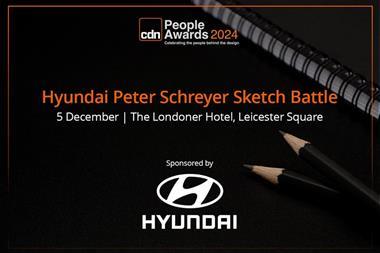





Graduating Masters student John-Paul Gregory presented an 'extreme offroad' mid-engine Volkswagen similar in size to the Concept R, intended to raise Volkswagen's profile amongst younger buyers.
Graduating Masters student Andy-Hart Barron presented a VW 'next-generation fun car' featuring a unique exposed roll cage. The cage defines the cabin area and forms part of an assymetric graphic element that encapsulates the vehicle body, reminiscent of the design elements seen on running shoes.
5th and 7th semester students presented proposals for an open sports car for 2-4 people, in the tradition of the British Roadster. The spirit of the classical roadsters was to be adapted on a new vehicle, while avoiding excessive retro elements.The challenge of these works was in the reduction of the 'roadster experience' to its key characteristics. 5th semester students designed exterior proposals, while the 7th semester focused on interior design.
Karsten Schmidt presented 'AC Mamba', with inspiration from the legendary AC Cobra of the sixties. The name 'Mamba', comes from the most poisonous snake in Africa. The Mamba shows the typical roadster proportion of short overhangs, long hood and elegant, exciting shape. The car is divided in two pieces ? the first part is the engine area and the passenger area, in anthracite. The second part is like a cover which demonstrates the simplicity of construction. To show the passion and emotion of this new car, restraints as on a rollercoaster replace the normal seatbelt system. Agressive wheel rims again show the association with the poisonous Mamba snake.
First semester Masters students presented exterior proposals for a Formula1 Sports Car for the 2020 season. The sculpture of the vehicle should be an indication for the dramatic art and dynamics of the race. Second semester Masters students presented interior proposals, with the placement of the driver determined by the function of the vehicle and the demands of controllability in extreme situations. These were presented as digital renderings and animations.
In a project entitled 'Blues Brothers', 4th semester transportation design students proposed a police patrol car for the year 2014. Exterior, graphic and special characteristics should mark it clearly as police car and establish a new design language for emergency vehicles. New forms were to be developed according to the special requirements of a region selected by the students. Locations from Iceland to South America were selected as basis of the design, resulting in a wide spectrum of results. The designs were developed and presented as digital models using Alias StudioTools software.
4th semester ID students presented an ocean-capable multi-hull boat for the leisure range, which offers space for six people and is primarily wind-powered. The rapidly developing technology of multi-hull boats opens to the designers a multitude of new concepts, layouts and functionalities within the yacht sport sector. Beside the exterior former model, the living and sleep quarters were to be sketched and represented as well as the navigation space.
The Pforzheim Transportation design department is located on the outskirts of the town of Pforzheim, on the edge of the Black Forest, between Stuttgart and Karlsruhe.
The first three semesters of the Transportation Design course are taught in conjunction with the Industrial Design course, and in the 4th semester of the course the students begin to specialize in Transportation Design. During this semester the students develop their design projects from 2D to 3D using digital models rather than clay, using Alias|Wavefront Autostudio for modelling, packaging studies, renderings and animations. Only in the 5th semester do the students develop their projects with the use of clay models. This emphasis on digital design techniques early in the course reflects the changing nature of the automotive design process.
The computer department has 15 workstations with 10 devoted to Alias programmes. The school has a great deal of support from the car industry through sponsored projects and regular visits from designers who tutor students in the various aspects of Transportation Design. BMW, Audi and VW regulary offer internships while Porsche and Mercedes are just around the corner.
The school has a Master of Transportation Design program (MTD) which is a 3 semester course. A diploma or degree in Industrial design is required for acceptance on this course but students gaining entry will have a certain level of freedom in planning the course structure. The school aims to take on a wide variety of students who will eventually be capable of working in all aspects of transportation design.








































